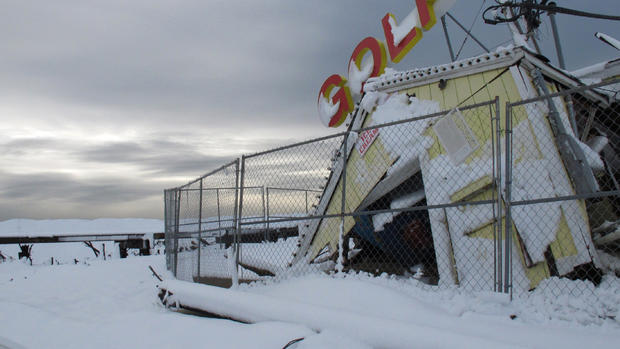Veterans compare Sandy's damage to "war zone"
When Joseph DiGiovanni described areas ravaged by superstorm Sandy on New York's Staten Island, he compared it to devastation he's seen before.
"It looks like a war zone," he said. "We know what a war zone looks like, and it looks like a war zone."
A U.S. Army specialist in Vietnam in the 1960s, DiGiovanni received two Purple Hearts for injuries he sustained when the ammunition belt of his machine gun was hit during an attack. He lost his left pinky finger and still has pieces of shrapnel in his chest and eyes. (It hasn't affected his eyesight "so far," he said.)
Now, he's the commander of Staten Island's chapter of Disabled American Veterans, a charity founded in 1920 by veterans who were disabled during World War I. After Sandy cleared, DiGiovanni, like leaders of other groups in New Jersey and New York, rallied his troops of fellow veterans to help their comrades.
With about a dozen volunteers at a time, DiGiovanni and his group have spent most of the two weeks since the storm bringing donations of blankets, food and water to as many of the island's roughly 1,000 veterans as he can.
"A lot of our guys lost their houses," DiGiovanni said, adding that the damaged houses he's seen "look like they've been bombed."
Just east of Staten Island, on New York's Long Island, Dennis Sullivan made similar comparisons between the damage he saw and his military service.
"It was like I'm back in Vietnam," he said. "I was talking to this lady, and I wanted to cry."
In Lindenhurst, N.Y., Sullivan said he helped one woman search through the wreckage of her house for a prized photo album.
"We finally found half of it," said the Vietnam vet. "We were hugging each other. I don't even know this woman, and we were hugging each other."
Sullivan was a personnel clerk for the Army, working as an alcohol and drug counselor in Da Nang, Vietnam, in 1971. Now he's in charge of the disaster relief fund for the New York branch of the Veterans of Foreign Wars.
The fund recently received a $50,000 donation for VFW members who lost their homes during Sandy, Sullivan said. He split the donation up and has been handing out $500 each to veterans who suddenly found themselves homeless.
"It's not much, but if they lost their house it can help," Sullivan said.
To be sure, Sullivan's handouts aren't the only resources available to storm victims. The Federal Emergency Management Agency has provided more than $300 million in emergency aid since Sandy, including vouchers so displaced people could stay in hotels. Last week, the agency announced it was bringing in manufactured housing. Also, the American Red Cross has been distributing blankets, gloves and meals, among other items, in storm-ravaged neighborhoods.
To help victims of Sandy, donations to the American Red Cross can be made by visiting Red Cross disaster relief, or you can text REDCROSS to 90999 to make a $10 donation.
The VFW's fund has also opened up six soup kitchens in Long Island's Nassau and Suffolk counties as well as Staten Island and the other New York City boroughs of Brooklyn and Queens. On Friday, Sullivan visited one VFW soup kitchen on Long Island and said it was serving about 110 people.
"It was just devastating what I'd seen the other day, and then we got hit with four inches of snow," he said, referring to Wednesday's nor'easter that added more power outages to the area.
In New Jersey, the VFW's adjutant quartermaster for the state, Bob Pinto, said he's been giving out money to not just VFW members who lost their home or remain without electricity, but also to any military personnel who have been on active duty within the past three years.
Unlike Sullivan, Pinto wouldn't disclose how much the group's giving to New Jersey veterans.
"There's too many unreliable people out there that are looking to make a buck," Pinto said.
Out of the VFW's roughly 35,000 members in New Jersey, Pinto estimated on Friday that about 25 veterans who've been affected by Sandy have reached out to the organization. That includes one veteran who lost power and took refuge at the VFW post in Ocean County, which includes the hard-hit shore communities of Long Beach Island and Seaside Heights.
Separating the number of veterans Sandy affected from the tens of thousands who lost their homes or are still living without electricity is a challenge. According to Army Staff Sgt. Wayne Woolley, a National Guardsman and spokesman for New Jersey's Department of Military and Veterans Affairs, about 426,000 veterans call the Garden State home.
However, New York City was able to keep track of one group of veterans before, during and after the storm. The city had to relocate the 243 residents of a veterans-only homeless shelter when the facility in the Long Island City neighborhood of Queens was flooded by storm surge from the East River.
Evelyn Erskine, spokeswoman for the Mayor's Office of Veterans Affairs, said homeless people are asked if they're veterans when they go into one of the intake centers around the city. Those centers are staffed by city employees with military backgrounds.
"Obviously the city feels that these people served our country," said Heather Janik, a spokeswoman for the Department of Homeless Services, "and we want to make sure that we're there for them."

